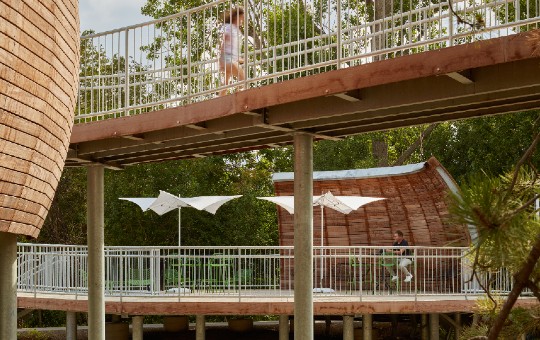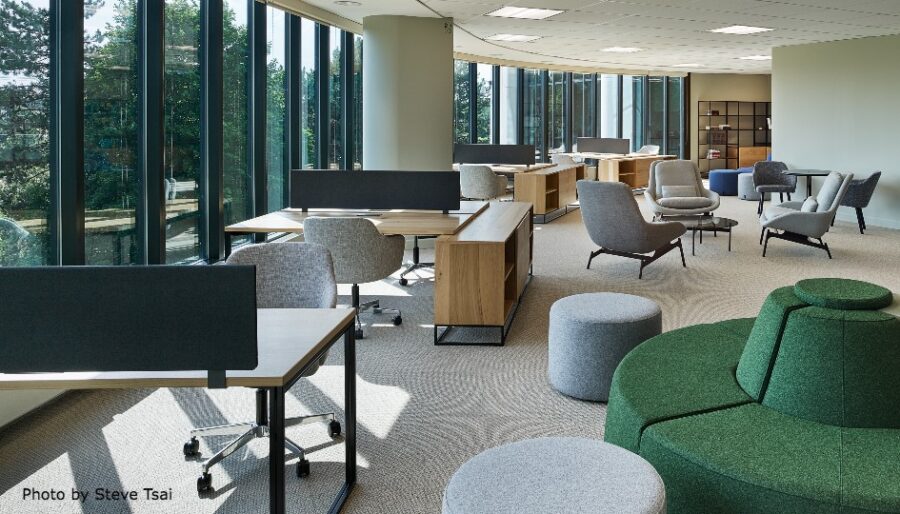Overhauling Manulife’s Canadian head office in Waterloo, Ontario during the pandemic, while consolidating teams from nearby Kitchener, became an even more significant project than previously intended in 2018 when plans were initiated.
In 2020, just as office-goers were settling into the first newly designed floors, COVID-19 hit and everyone shuffled to remote work. But as it turns out, the overall vision for the office was the crystal ball of workplace transformations. “The timing could not have been worse, but it could not have been better,” says Jennifer Tinson, creative director of workplace at Figure3, the design firm helming the interior renovation.
“When employees came back, the whole project was realized. In some ways, it was the perfect unveiling for something brand new and done at a time when people were expecting and needing a complete change.”
Upon entering the 330,000-square-foot building on King Street, choice and flexibility are embedded throughout the activity-based workplace—a model that was more cutting-edge pre-pandemic and bodes well with newfound hopes for hybrid arrangements, which many of the 3,400 employees now enjoy.
As Figure3 Principal Eric Yorath explains, the model facilitates an office where people will want to return to because they have control over how they work, able to choose from a variety of spaces, whether that be collaborative or heads-down. An essential part of the project was achieving a campus-like destination with abundant amenity offerings within the complex so people can feel part of a larger community.
A focus on employees was an evolving theme from the get go. Michael Miceli, Managing Director at Manulife, calls the project a collaborative effort, one in which everyone could feel heard. Ultimately, a hybrid work schedule was established. People work on site Tuesdays and Wednesdays, which are intended for casual collisions, more socialization, learning opportunities, and to rekindle relationships and focus on creativity.
“It was a huge opportunistic play for us and for the employees—to create an environment for them to be more productive, to have more collisions, to be able to interact with each other in a more positive way, bringing in more natural light— so many factors,” says Miceli.
Daylight fills the lobby and carries through the space where expansive windows offer views to the natural surrounding landscape outdoors. Walls of greenery boost emotional well-being, alongside a mix of quiet and social areas that become destination points for workers to choose from as they travel along intuitive pathways across the five 65,000-square-foot floors.
As Tinson explains, much thought was given to what resonates with people as soon as they enter the doors and as they move through the space. “We talked a great deal about feeling like you would be part of a bigger whole, part of something important and recognized as a person who had a valuable contribution to make,” she says. “We tried to be aware of what it felt like to be that individual; it didn’t matter where you sat or how your day unfolded—there would be a place for you to go to conduct your business or personal issues within a framework that made sense to you.”
While they’re at work, employees have a choice to be as exposed or private as they wish. The conference centre can turn into an event lounge. Three 24-person meeting rooms with retractable ceiling partitions allow for theatre-style seating for around 200 people.
A wellness centre, with lockers and shower facilities, features multipurpose and reflection rooms, a refreshment lounge, and bike storage. In the cafe, are lunch, snack, and after-hours options, with direct outdoor access to a terrace that is ideal for socializing, dining or other staff activities.

Photo by Riley Snelling.
From the terrace, a walkway meanders towards three gathering pods and a larger trail system.
Local architecture firm Martin Simmons Sweers brought in Ipe wood decking for a warm, tactile experience and curved wood screens for the pods to allow for private, shaded moments.
Out front, a staff drop-off area brings revamped parking, sidewalks and a new driveway.
The wow factor
Renovating the building wasn’t without challenges. “There were lots of players at the table. Everyone wanted something out of this, understandably,” says Tinson. “They wanted the best for their people and their own initiatives under the umbrella of Manulife and we had to be very sensitive to that.”
Throughout the process, platforms and presentations came with regular updates that responded to questions and concerns from all parties, including the business.
As the project also began with a restricted budget, it took some grasping to realize a captivating and effective design without a tremendous financial footprint, adds Yorath. When contemplating what the “quintessential wow factor” executives decided the new dynamic of the office, with its different design approach, was enough of a buzz to get people talking without the huge investment.
Designing for evolution
Getting people back to the office remains a universal challenge among players in corporate real estate. C-suites are facing tough decisions when contemplating perfect workplace solutions. “COVID has become a global disrupter. What it has created for leadership, in addition to running their business, is their mindset is not as deliberate and strategic because there’s a lot of emotion,” says Miceli.
“We’re all trying to revisit and rethink, and I’d say that what resonates loud and clear is that activity-based work is here to stay.”
Emotional intelligence must play a more prominent role post-COVID, adds Tinson. “It’s forcing leaders to always be sitting in the shoes of people who have to experience the decisions they make. You can alienate a lot of people if you’re not thinking clearly about the message you’re sending and the example you’re setting.”
Hospitality-like strategies also figure prominently into the future office, says Yorath. “Try to understand that we are still in the midst of the largest workplace strategy pilot ever conceived for mankind and recognize that you are in a position to learn so much about what your specific culture needs in order to work,” he further advises.
Going forward, the idea of space design being efficient for the term of a 10 to 15-year lease is an antiquated outlook compared to more evergreen models, he adds. “We’re in a world where the office will need to continue to flex and morph with the shifting appetite of the culture that it’s facilitating. We need to design spaces for evolution.”
Feature photo by Steve Tsai.




